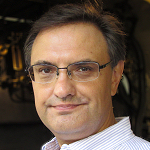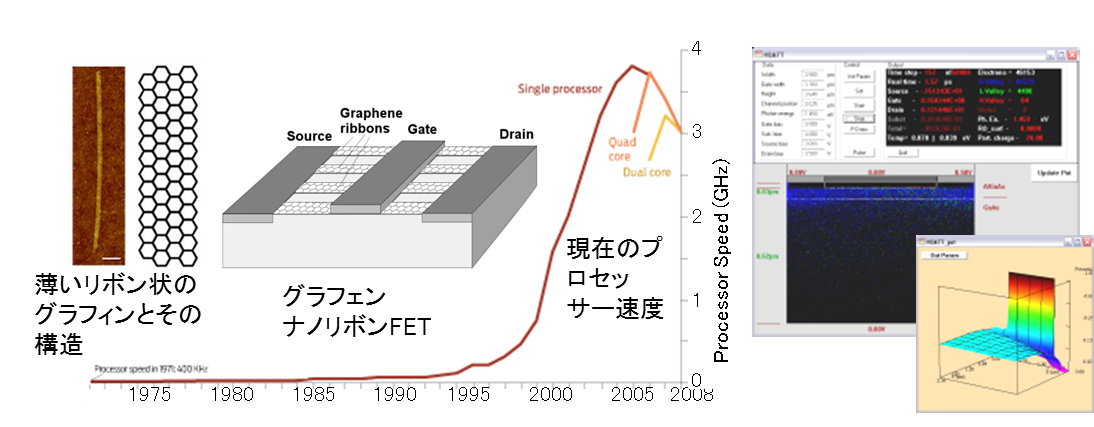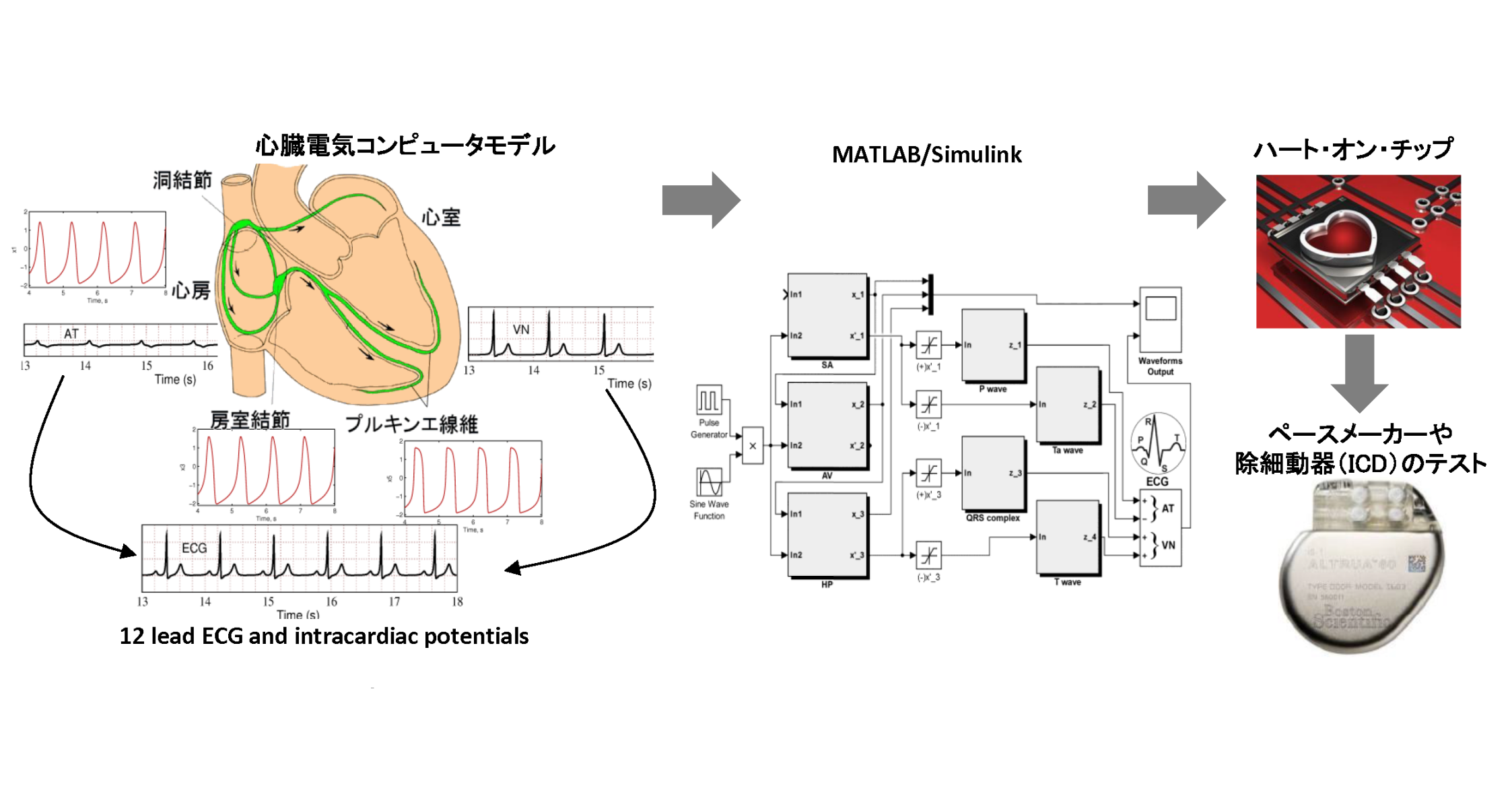
リズィー マキシム RYZHII Maxim V.
上級准教授
- 所属
- コンピュータ理工学科/コンピュータ・サイエンス部門
- 職位
- 上級准教授
- m-ryzhii@u-aizu.ac.jp
教育
- 担当科目 - 大学
- NS02 電磁気学(講義)
NS02 電磁気学(演習)
NS04 半導体デバイス
NS05 熱・統計力学
- 担当科目 - 大学院
- SYA06 コンピュータおよび通信システム用の高度なデバイス
SYA07 高度な半導体デバイスのモデリング
研究
- 研究分野
-
電子デバイス及び電子機器
計算科学
生命、健康及び医療情報学
生体医工学
ナノ電子デバイスの物理およびコンピュータモデリング、生物物理モデリング
- 略歴
- 2019 会津大学 上級准教授
2003 会津大学助教授・准教授
1998(03-09) チャルマーズ工科大学 客員研究員
1993 会津大学助手
2001 東京工業大学 工学博士
1992 モスクワ物理工科大学修士課程修了
- 現在の研究課題
- ○理論とコンピュータモデリング:グラフェンナノ電子デバイス, テラヘルツ(THz)放射線の検出器および発生器
○心臓電気伝導システムおよび心電図のモデリング
- 研究内容キーワード
- コンピュータモデリング、モンテカルロ法、非線形システム、発振器
- 所属学会
- IEEE Electron Devices Society (EDS, 上級会員), IEEE Engineering in Medicine and Biology Society (EMBS),
American Physical Society
パーソナルデータ
- 趣味
- スキー、トレッキング、水泳
- 子供時代の夢
- 携帯電話を作る
- 座右の銘
- 明日死ぬかのように生きろ。永劫永らえるかのように学べ。
- 学生へのメッセージ
- 常に何か役に立つことを学ぶことを希求しなさい。
主な研究
- グラフェンを用いたナノエレクトロニック装置のコンピュータモデリング
-
〇グラフェントランジスタ
過去数十年におけるコンピュータのスピードの増加は注目すべきことであるが、それも終わりを迎えて来ている。一つの要因として、シリコン自体が物理的な限界に達していることが挙げられる。
しかし、最近になって、シリコンよりも高速に電子を流せる新しい素材、グラフェン(graphene)が発見された。グラフェンは単原子シートの中に配置されている炭素原子から成り立っている。これは、一般的な鉛筆を成す黒鉛の構成要素でもある。
グラフェントランジスタは、今日のシリコントランジスタよりも100~1,000倍の速度で電子を走らせることが可能である。
この研究により開発されたコンピュータモデルとオリジナルのシミュレーションソフトはFET、検知器、レーザーのような異なるグラフェンをベースとしたナノエレクトロニック装置の動作を調べるために利用される。
- 心臓電気現象コンピュータモデリング
-
○ 私達は心臓の単振動モデルを使って心臓の電気的な活動を研究しています。私達は心臓の不整脈とカオスのメカニズムを研究しております。私達の心臓の非線形力学的なモデルは正常及び異常な状態の心臓伝達系の動作を再現することができます。私達とともにコンピューターシミュレーションを使って心臓の電気的な活動を研究することによって沢山の興味深い発見ができるかもしれません。
○ 私達のモデルは振動しているペースメーカー細胞や興奮性筋を含む互いに連結された振動子としての刺激伝導系の働きのシミュレーションを可能します。
私達は次のようなテーマを研究しています
・異なった種類のペースメーカー細胞や心筋
・心臓病
・人工的な心臓ペースメーカー
・心拍への外的な刺激の影響
○ 私達は、このモデルを使用してペースメーカーや除細動器(ICD)のソフトウェアとハードウェアのテスト及び閉ループ系における検証ための速く、比較的簡単であり、効率的に計算できるFPGA実装(ハート・オン・チップ)を含むシステムを開発しています。
主な著書・論文
Selected publications:
- M. Ryzhii and E. Ryzhii. "A compact multi-functional model of the rabbit atrioventricular node with dual pathways", Frontiers in Physiology, 14, 1126648, 2023.
- M. Ryzhii, V. Ryzhii, M.S. Shur, V. Mitin, C. Tang, T. Otsuji. "Terahertz bolometric detectors based on graphene field-effect transistors with the composite h-BN/black-P/h-BN gate layers using plasmonic resonances", J. of Applied Physics, 134, 084501,2023.
- M. Ryzhii, V. Ryzhii, T. Otsuji, V. Mitin, and M.S. Shur. "Coulomb drag and plasmonic effects in graphene field-effect transistors enable resonant terahertz detection", Applied Physics Letters, 120 (11), art. no. 111102, 2022.
- M. Ryzhii and E. Ryzhii. "Pacemaking function of two simplified cell models", PLoS ONE, 17 (4), art. no. e0257935, 2022.
- M.A. Quiroz-Juarez, O. Jimenez-Ramirez, R. Vazquez-Medina, E. Ryzhii, M. Ryzhii, and J.L. Aragón. "Cardiac conduction model for generating 12 lead ECG signals with realistic heart rate dynamics", IEEE Transactions on Nanobioscience, 17 (4), art. no. 8466837, pp. 525-532, 2018.
- M. Ryzhii, T. Otsuji, V. Ryzhii, V. Mitin, M.S. Shur, G. Fedorov, and V. Leiman. "Dynamic conductivity and two-dimensional plasmons in lateral CNT networks", Int. J. of High Speed Electronics and Systems, 26 (1-2), art. no. 1740004, 2017.
- M.A. Quiroz-Juárez, R. Vázquez-Medina, E. Ryzhii, M. Ryzhii, and J.L. Aragón. "Quasiperiodicity route to chaos in cardiac conduction model", Communications in Nonlinear Science and Numerical Simulation, 42, pp. 370-378, 2017.
- E. Ryzhii and M. Ryzhii. "A heterogeneous coupled oscillator model for simulation of ECG signals," Computer Methods and Programs in Biomedicine, 117(1), pp. 40-49, 2014.
- M. Ryzhii, V.Ryzhii, T. Otsuji, P.P. Maltsev, V.G. Leiman, N. Ryabova, and V. Mitin. "Double injection, resonant-tunneling recombination, and current-voltage characteristics in double-graphene-layer structures," Journal of Applied Physics, 115(2), 024506 (1-8), 2014.
- T. Otsuji, S. Boubanga Tombet, A. Satou, M. Ryzhii, and V. Ryzhii. "Terahertz-wave generation using graphene: Toward new types of terahertz lasers," IEEE J. of Selected Topics in Quantum Electronics, 19(1), 8400209(9), 2013.
- M. Ryzhii, T. Otsuji, V. Mitin, and V. Ryzhii. "Characteristics of p-i-n terahertz and infrared photodiodes based on multiple graphene layer structures," Japanese Journal of Applied Physics, 50, pp. 070117 (6), 2011.
- M. Ryzhii, V. Ryzhii, T. Otsuji, V.Mitin, and M.S. Shur. "Electrically induced n-i-p junctions in multiple graphene layer structures," Physical Review B, 82, 075419 1-6, 2010.
- M. Ryzhii and V. Ryzhii. "Physics and modeling of tera- and nano-devices," World Scientific Publishing Co Pte Ltd., Singapore, 2008.
- M. Ryzhii, V. Ryzhii, and M.S. Shur. "Effect of near-ballistic photoelectron transport on resonant plasma-assisted photomixing in high-electron mobility transistors," Semiconductor Science and Technology, 19(4), pp. S74-S76, 2004.
- M. Ryzhii and V. Ryzhii. "Monte Carlo modeling of transient recharging processes in quantum-well infrared photodetectors," IEEE Transactions on Electron Devices, 47(10), pp. 1935-1942, 2000.
- M. Ryzhii, M. Willander, I. Khmyrova, and V. Ryzhii. "Terahertz response of metal-semiconductor-metal photodetectors," Journal of Applied Physics, 84(11), pp. 6419-6425, 1998.




